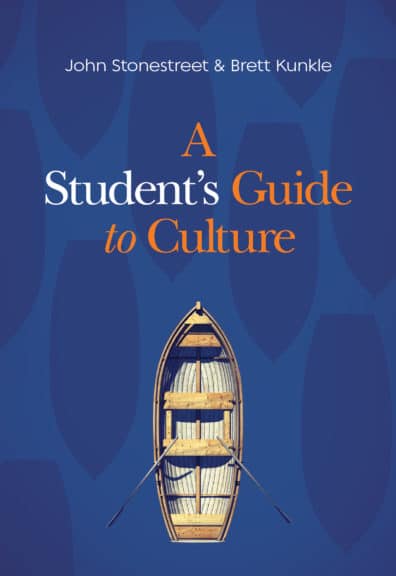Editor’s Note: This post is an excerpt from A Practical Guide to Culture by John Stonestreet and Brett Kunkle.
Among Christians, culture is a word much used but rarely defined. It comes from the Latin word cultura, which means “agriculture.”
In its most basic sense, culture refers to what people do with the world: we build, we invent, we imagine, we create, we tear down, we replace, we compose, we design, we emphasize, we dismiss, we embellish, we engineer. As Andy Crouch says, “Culture is what human beings make of the world.”
Culture was an integral part of God’s plan for us and His world from the very beginning.
Cultivating is exactly the sort of behavior the Scriptures would have us expect from God’s image bearers. After all, He commanded our first parents to “be fruitful and multiply and fill the earth and subdue it” (Gen. 1:28).
God made humans with the capacity to do something with His world, and that’s exactly what we do. Culture was an integral part of God’s plan for us and His world from the very beginning.
What Culture Is and What It Does to Us

[Culture] is not the same thing as nature, or creation. There is a world outside ourselves that God created. “In the beginning,” says Genesis 1:1, “God created the heavens and the earth.”
Culture doesn’t refer to this created world; rather, it refers to what humans do with it.
To clarify a bit further, culture refers not to what humans do by instinct or nature (like circulating blood, eating food, having sex, or sleeping) but to what they do freely (like donating blood for a good cause, garnishing food before serving it, committing to marital monogamy, or sleeping in elaborately decorated beds with more pillows than one could possibly need in a lifetime).
[To] summarize, cultures consist of those products of human activity that have collectively taken on a life of their own.
The worlds we create powerfully influence our lives by convincing us of what is normal.
As we live in a culture, we become committed to its vision of life, unless we’re intentional otherwise. In other words, we make our cultures, and then our culture shapes us.
Keeping the Moment and the Story Straight
[The] Scriptures describe reality as it actually is.
One might refuse to believe in gravity, but stubbornness doesn’t change truthfulness. The Scriptures are like gravity in that they’re true whether we believe them or not. But they differ from gravity in that they don’t describe just one particular aspect of reality.
Rather, they describe the Big Story of reality. Granted, the Scriptures don’t give specific details about everything, but they do provide the overarching Story of the world, humanity, and history.
They tell us where everything came from, including us, and where everything is going, including us.
[We] must learn to approach our cultural moment from the Big Story. Otherwise, we’ll miss the meaning of both the moment and the Story.
Reeling from a tragedy or an election, trying to navigate a world where wrong is right and raunchy is popular, we often become reactionary and approach culture by asking the wrong question first.
First, not everything labeled Christian is good, and not everything labeled secular is bad. Much that is labeled Christian—movies, songs, leaders, schools, churches, ministries, and organizations—fails to reach basic levels of excellence and honesty.
One might refuse to believe in gravity, but stubbornness doesn’t change truthfulness. The Scriptures are like gravity in that they’re true whether we believe them or not. But they differ from gravity in that they don’t describe just one particular aspect of reality.
And much that is labeled secular accurately portrays fallen humanity, displays artistic genius, and brings good to the world.
As Gregory Thornbury, the president of The King’s College, is fond of saying, “‘Christian’ is the greatest of all possible nouns and lamest of all possible adjectives.”
It’s meant to be a person, not describe a thing.
Having Standards
Of course, Christians must have standards. Scripture is clear that we ought not associate with “works of darkness” (Eph. 5:11). At some point, we’ll have to ask ourselves, “Does this cross the line?” But that isn’t the right question to ask first.
The apostle Peter addressed his first epistle to Christians during a difficult cultural movement.
Blessed be the God and Father of our Lord Jesus Christ! According to his great mercy, he has caused us to be born again to a living hope through the resurrection of Jesus Christ from the dead, to an inheritance that is imperishable, undefiled, and unfading, kept in heaven for you, who by God’s power are being guarded through faith for a salvation ready to be revealed in the last time. (1 Pet. 1:3–5)
This reality, Peter wrote, would enable Christ followers to endure trials, resist temptation, love their enemies, do good, and live well in the cultural movement.
Throughout the letter, as he sought to encourage his troubled audience, he returned again and again to the truth that defined their moment.
It defines our moment as well, as it does every moment of human history. Christ has risen from the dead. Our hope is secure.
Like all good stories, the biblical story line includes an introduction, a protagonist, antagonists, conflict, and resolution.
This Story Is Different
Yet this Story is different from all other stories because it’s God’s Story. As such, it accurately describes reality, including what has gone wrong and how God will bring history to its conclusion according to His purposes.
“What does this have to do with culture?” you may be asking.
Everything.

If the Scriptures tell the true Story of the world, then our current cultural moment is part of its storyline. Thus, the only way to make sense of our moment is by placing it in its true context.
[It] can be summarized in four chapters: creation, fall, redemption, and restoration.
Here’s a brief summary:
Creation
Only by beginning where the Story began can we grasp the gravity of all that follow[s]. The problem isn’t that humans make culture. The problem is the type of culture humans make.
Fall
In the biblical Story, we are both the antagonists causing the problem and the victims in need of rescue.
Therefore, we should always be wary of those who claim, by human ingenuity or effort, that they will fix the world.
Utopian visions, like the ones tried throughout the twentieth century (including Communism, eugenics, and sexual autonomy), will always fail.
They leave individuals, nations, and entire civilizations riddled with bloodshed and chaos.
Redemption
[Jesus] took on the sin of the world, suffered God’s wrath in our place, and ultimately defeated death by rising from the grave. All who embrace Christ are forgiven and become the children of God. If that was all Christ accomplished, it would be enough to demand our worship and allegiance. But there’s more.
In Christ, death is defeated—not only for us as individuals but also on a cosmic level. The Story did not end at Christ’s resurrection, or at our redemption. There is a fourth chapter.
Restoration
[The] final chapter of the Story is summarized in the words of Christ Himself with a present-tense verb: “Behold, I am making all things new” (Rev. 21:5).
[The] God who once walked with Adam and Eve in Eden will make His home with His people. “He will dwell with them, and they will be his people, and God himself will be with them as their God” (Rev. 21:3).
When He makes His home with us, all wrongs will be made right, and all lies will be exposed as untrue.
A Better First Question
We live in this cultural moment, but it hovers between redemption and restoration.
Thankfully, before His ascension, Jesus offered instructions on how to live in this moment: “A new commandment I give to you,” He said, “that you love one another: just as I have loved you, you also are to love one another” (John 13:34).
We’re to be disciples who make other disciples (Matt. 28:18–20). Paul tells children to obey their parents and husbands to love their wives. We should be good citizens, Peters instructs us (1 Pet. 2:13-15).
And we’re to wait expectantly for the culmination of the Story, which occurs when Christ returns (rom. 8:22-24).
There are many more instructions than we have space to walk through, but two deserve our attention here.
First, as Peter wrote to the exiles facing their tough cultural moment, we are to be defined by hope (1 Pet. 3:15). The believers’ hope, secured through the resurrection of Jesus Christ, isn’t subject to fickle feelings shaped by the cultural moment.
Second, the New Testament employs all kinds of “re” words to describe life between redemption and restoration: renew, repent, restore, regeneration, reconciliation.
Reconciled ones are to be reconcilers (2 Cor. 5:18).
The Story is the context of our cultural moment. We must live from it and allow it to shape us. That’s why there’s a better first question with which to approach culture than “Where do we draw the line?” or “Have we lost?”
The better question is “What is our salvation for?”
Reconciled ones are to be reconcilers
(2 Corinthians 5:18).
What Is Our Salvation For?
Living in this good-yet-fallen place means living in tension. Sin and evil have thoroughly infected this beautiful world.
People have profound capacities not only for justice, kindness, and love, but also for injustice, cruelty, and hate.
Two reactions tempt the church in every generation. The first is to flee from culture. Shouldn’t we withdraw into the safety of the church, take care of our own, and avoid the darkness?
The other reaction is simply to avoid controversial issues. This way, we’re told, we can keep the focus on God’s love for all people. Both of these reactions offer ways to escape the tension.
But Christianity, unlike other religions, is not escapist.

Buddhism calls its adherents to escape from the world through meditation and mental focus. Hindus consider the physical world an illusion to be escaped through the births and rebirths of reincarnation.
America’s most popular religion, a syncretistic, New Agey sort of spiritual self-helpism, teaches that we can escape stress and self-doubt by following our hearts (or something like that).
At the center of Christianity, however, is Jesus Christ, the God who put on skin and “moved into the neighborhood” (John 1:14 THE MESSAGE). The Christian faith is incarnational.
The incarnation means that Christianity is no “Let’s get out of here so we can stay safe from the evil world until God takes us out of here” sort of religion.
It’s important to note that God’s people can still make a difference in the world.
Christ Saved Us
You see, Christ didn’t save us from being human; He saved us so that we would be fully human again.
The Story the Scriptures tell clarifies that just as God intended His image bearers to bring life to the world by ruling over it as He would, He intends for redeemed humans to join His world in bringing new life to the world.
When mature Christians engage the culture fully, deeply, and wisely, the culture won’t corrupt us. Just the opposite. We’ll be teachers of the culture. We’ll teach it what is good, true, and beautiful.
You see, Christ didn’t save us from being human; He saved us so that we would be fully human again.
What is cultural success? It’s a life lived deeply engaging the moment in which God has placed us and courageously navigating the threatening currents, knowing that we serve a cause, and a God, far greater than ourselves.
Called to Our Times, Not Another
We must talk about certain things, including topics we’d rather avoid.
[Kids] will grow up, fall in love, and watch their friends, families, and neighbors do the same. Whom will they fall in love with? Are they free to act on all of their romantic feelings, even if they are same-sex attracted?
Should they attend a friend’s same-sex ceremony? Not to clarify the cultural issues of our day with the next generation is a dereliction of duty.
So, let’s do just that. Let’s get into some of the larger cultural issues.
Gender Identity
The newest word [we] have learned is cisgender.
Even if you haven’t heard it before, your teenagers likely have. According to Wikipedia, cisgender refers to individuals “who have a gender identity that matches the sex that they were assigned at birth.” Two assumptions are embedded in Wikipedia’s definition of cisgender.
First, that sex is “assigned” and not a biological reality. And second, that gender is chosen, not innate.
Don’t Buy the Cultural Lies
Lie #1: Gender is merely a social construction.
When it comes to gender and sexuality, our culture says there are no objective truths, only subjective preferences. If you feel it, declare it, and it is so. Gender, we’re told, is not a fixed trait rooted in biology; instead, it’s a social construct that culture creates.
One way to undermine the claim that gender is merely a social construction is to test-drive the idea and see where it leads. In logic, this form of reasoning is known as reduction ad absurdum (literally “reduction to absurdity”).
A video that went viral on YouTube illustrates the absurdities of this claim about gender identity.
[After watching this,] we have to stop and ask ourselves, Why were seemingly bright, young college students unwilling to counter obvious absurdities? Intellectual consistency.
Social construction is free to go anywhere our minds will take us. The absurdities are endless.
But this logical slippery slope can’t hold up under the weight of its own consequences. If we self-identify as sixty-five-year-old-men, should the federal government start sending us Social Security checks?
If we self-identify as six-year-old girls, should we be able to enroll in a first-grade class at the local public elementary school?
If we self-identify as a particular minority, should we be able to receive college scholarships earmarked for that minority group?
If the answer is no to any of these questions, then why is a biological male who identifies as a female allowed to impact the laws of the land so that he can use the restroom or locker room of his choice or make sure fines are imposed on those who don’t use transgender pronouns?
Social construction cannot maintain logical consistency; therefore, the idea should be rejected.
Lie #2. We should validate people’s thoughts and desires so they’ll flourish.
The culture says, “Be who you are” and “Do what you want.” Whatever reality you select for yourself is just fine.
How do we know biologically that someone is a male or female? Objective facts about physiology, anatomy, chromosomes, and DNA exist. Maleness and femaleness are undeniable physical realities.
As difficult as it may be for transgender people to hear, we must examine possible phycological causes for gender confusion.
[An] incongruence between one’s physiological and physical reality isn’t unfamiliar to most of us. For example, a ninety-pound teenage girl who struggles with anorexia may believe she is grossly overweight, but doctors won’t tell her to accept her feelings and change her body.
They don’t doubt her feelings, but they consider her self-perception incorrect.
People with body integrity identity disorder (BIID) also believe their physical form doesn’t match how they feel they should look, so they want to amputate otherwise healthy limbs.

Doctors don’t cooperate with their feelings by hacking off undesired body parts. Instead, they recognize an underlying psychological condition that must be treated.
Only in the case of transgenderism are physical solutions offered for a psychological incongruence.
Two-thirds of transgender people suffer from multiple psychological disorders, such as depression and phobias. Transgender rates of depression and anxiety “far surpass the rates of those for the general population.”
Forty-one present of transgender men and women attempt suicide. That’s a staggering statistic in light of the rate among the general population, which is 1.6 percent.
There are serious consequences when we buy into cultural lies.
Recapture the Wonder of God’s Story
You won’t find the word transgender in Scripture, but that doesn’t mean the issue isn’t addressed. God speaks directly and explicitly about gender in the creation account: “Male and female [God] created them” (Gen. 1:27).
God didn’t make gender-neutral humans. Gender isn’t a social construct, nor is it assigned. It’s part of God’s design, deeply grounded in His created order and woven into the fabric of reality.
Thus, gender is a gift from God.
The distinction between male and female does nothing to undermine the value and dignity of either. Both are made in the image of God, and our equality is secured by that fact alone.
No distinction—ethnicity, gender, age, sex—threatens the equality of human beings. All are image bearers.
For the person struggling with gender identity, God’s Story offers not only an accurate diagnosis but also the singular cure.
Every issue we [could discuss]—whether pornography, the hookup culture, homosexuality, or transgenderism—is open defiance of our creator. We’re not just broken; we’re rebellious. Romans 1:21–32 graphically captures humanity’s revolt and its results.
Not every human desire is proper (James 1:13–14).
The only thing that will put a fractured human being back together is the One who fashioned him or her.
First, God redeems us from our sin through the work of Christ on the cross. Second, His Story shows us how we were made and how He intended us to function properly.
We must tether ourselves to God’s Story.
Action Steps
- Let God move you to compassion for men and women who struggle with gender-identity issues.
- Talk to your kid about gender.
- Fathers, from the beginning cultivate warm, loving relationships with your sons and daughters.
- Mothers, from the beginning cultivate caring, nurturing relationships with your sons and daughters.
- Work hard to cultivate a strong, healthy marriage.
- Watch two DVD presentations from Living Hope Ministries. Here and here.
- Speak the truth carefully, with an extra dose of compassion.
- Take the long view on this issue and be prepared for things to get worse.
Addiction
Empty. That’s our culture. [We] express and cope with our inner emptiness in a myriad of ways, from sexual immorality to chronic consumerism. And today, more people, especially kids, are turning to drugs and alcohol to soothe their souls.
Don’t Buy the Cultural Lies
Lie #1: Drug and alcohol abuse aren’t that big of a problem in our culture.
In a survey of high school students, researchers found the following over a twelve-month stretch:
- 58% of twelfth graders used alcohol.
- 35% of twelfth graders used marijuana.
- 7% of twelfth graders used amphetamines.
- nearly 24% of twelfth graders used illicit drugs.
Among college students,
- 79% reported drinking alcohol;
- 35% reported binge drinking;
- approximately 6% reported daily or near daily or near-daily marijuana use—the highest rate since 1980;
- marijuana use over a twelve-month period rose from 30% in 2006 to 34% in 2014; and
- cocaine use rose sharply from 2.7% in 2013 to 4.4% in 2014.
Statically speaking, chances are that our kids and/or their friends will experiment with alcohol and drugs, if they aren’t already.
Lie #2: Legal drugs and alcohol are primarily used for recreational purposes. Even if you abuse them, you’re only hurting yourself.
When we look underneath the slick alcohol advertisements and the growing chorus of approval for marijuana, we discover a great amount of damage when these substances are abused.
There’s plenty of data to show the harm that accompanies drinking.
For example, college-age students have reported assaults (including sexual assaults and rape), unintentional injuries, academic problems, unsafe sex, health problems, property damage, confrontations with the police, suicide attempts and deaths, all related to alcohol abuse.
Today’s marijuana products [have] higher levels of tetrahydrocannabinol (THC), the psychoactive ingredient in marijuana that is shown to be addictive, mind altering, and harmful to the brain, resulting in detrimental cognitive and psychological effects.

The physical harm and destruction that substance abuse cause are just the tip of the iceberg.
We haven’t discussed issues like the heroin epidemic breaking out in places like Ohio and West Virginia, where in a town like Huntington, West Virginia, “one in four residents … is hooked on heroin or some other opiod.”
As followers of Jesus Christ, we know there’s a more fundamental matter than physical harm that must be dealt with. Addiction is the result of an emptiness in the soul, not of what’s put into the body.
Real rescue can be found only in God’s Story.
Recapture the Wonder of God’s Story
While Christians are often content with cleaning up the outward appearance, God is not. He is after a renovation of the heart.
A heart filled with the Holy Spirit is able to exert self-control from the inside out. In turn, self-control allows us to live in God’s good world while properly enjoying God’s Good things (Ps. 104:14–15).
Of course, the question of drugs in another matter. [The] very intent of using recreational marijuana, cocaine, heroin, or other illicit substances is to become intoxicated.
Partaking, in and of itself, is an attempt to get high and give control of oneself to the drug.
Sanctification is a lifelong process with many ups and downs.
Thankfully, God’s Story can catch us in the midst of the messiness and brokenness of life and move us toward the health and wholeness only the gospel of Jesus brings.
Action Steps
- Open your eyes to the real threat substance abuse is to your kids.
- Model self-control.
- Make family dinners an essential part of your routine.
- Go beyond the just-say-no model of sanctification.
- Explain the why.
- Regularly host your kids’ friends at your home.
- Teach from real-life examples.
- Confront your kids’ problems quickly.
- Get professional help when needed.
- Be wise with your freedom in Christ.
Race Relations
Many Americans hoped the election of our first African American president in 2008 would finally close the book on a part of our dark, divided history and bring racial reconciliation.
It clearly didn’t.
The subsequent protests and riots in the wake of high-profile police shootings of African Americans reveal that our country is still very much divided on the issue of race.
However, such a divide isn’t unique to the United States. The modern world is filled with strife between people groups, from the streets of Palestine to the tensions between North and South Korea to the conflict between the Kurds and the Turks.
In the recent past, racial conflict in Rwanda, Bosnia, and Darfur (Sudan) resulted in unspeakable violence and genocide. Chechnya. France. India. Sri Lanka. Russia. Bolivia. Belgium. Great Britain. Racial strife is found in nearly every country on earth.
I (Brett) have experienced it firsthand [as a young elementary-school kid]. No ethnicity, socioeconomic status, or cultural environment makes us immune to ethnic strife.
Racism isn’t an American problem, it’s a human problem.
How do we navigate this minefield with our kids?
Don’t Buy Cultural Lies
Lie #1: You are your ethnicity.
Culture tells us that our identity is inextricably linked to our racial classifications. We are Chinese, Mexican, Egyptian, Russian, Swedish, African, and so on.
Racial identity is innate and unalterable because race is in the genes. Therefore, a primary part of our identity is found in our ethnicity.
However, the biological differences between ethnic groups—the ones that account for shared characteristics among members of a race—are minuscule.
Researchers involved with the Human Genome Project have stated, “If you ask what percentage of your genes is reflected in your external appearance, the basis by which we talk about race, the answer seems to be in the range of .01 percent.” Thus, “the concept of race has no genetic or scientific basis.”
An overidentification with ethnic identity can unnecessarily exacerbate racial divisions.
Lie #2: Racism is nonexistent, so people need to get over it.
Simply peruse social media channels, and you’ll quickly discover blatant racism being spewed from the anonymity of computer screens.
Ask ethnic neighbors if they’ve experienced racism, and they’ll likely have a story to share of both personal and systemic discrimination.
Or ask yourself how you would respond if your son or daughter brought home a date with a different skin color than yours. There may even be seeds of racism in our own hearts.
Racism is detestable. Racism is sin. And racism is reality. Only by acknowledging it can we confront it.
Lie #3: Racism in the United States is happening everywhere all the time.
[In] 1958, only 37 percent of Americans expressed willingness to vote for a black person for president.
By 1999, that percentage had risen to 95 percent. In 2008, American voters elected Barak Obama to the White House and reelected him for a second term four years later.
Even more significant, in 1958, only 4 percent of Americans approved of interracial marriage between blacks and whites.
In 2013, 87 percent of Americans approved, representing “one of the largest shifts of public opinion in Gallup History.”
While recognizing contemporary race-relation problems, we also ought to acknowledge cultural progress.
Refusing to buy into a false narrative helps prevent Americans from descending into despair as we struggle to overcome racial strife.
Recapture the Wonder of God’s Story
According to Scripture, God started with the creation of one man, Adam, and from him descended “every nation of mankind.”
In God’s Story, there is one human race. C. S. Lewis paid tribute to this biblical truth, addressing the Pevensie children as the “sons of Adam” and “daughters of Eve” in The Chronicles of Narnia.
These dignified titles acknowledge our shared humanity as descendants of the original image bearers.
Our origin as God’s image bearers overrides our ethnic origins.
From it derives the inherent dignity of every ethnic group. God’s Story begins not with the racial superiority of some and the inferiority of others, but with the value and equality of all humanity.
People of color—all colors!—are precious in His sight.
The contemporary evangelical church finds itself [divided] based on social, cultural, and ethnic differences.
We have Caucasian, African American, Hispanic, and Asian congregations, dividing ourselves along humanly constructed lines.

This ethnic and cultural particularism ultimately runs contrary to the ethnic and cultural transcendence of the gospel that tells us, “There is no Jew nor Greek, there is neither slave or free, there is no male and female, for you are all one in Christ Jesus” (Gal. 3:28).
In Christ, we have one tool that can ultimately overcome racial strife and tear down ethnic barriers.
Imagine what a witness we would be to a racially divided world if the church recaptured that first-century, gospel-centered unity once again.
Action Steps
- Develop deep friendships with those of other ethnicities and listen carefully to them.
- Examine your own views.
- Expose your kids to other cultures and celebrate God-given diversity.
- Don’t let the culture control the conversation on race.
- Be “quick to hear” and “slow to speak” (James 1:19).
- Treat others as individuals.
- Avoid slogans and clichés.
- Hold up heroes of the faith who were of different ethnicities or who championed the rights of others.
- Share the gospel with all ethnicities.
- Be on the lookout for other expressions of discrimination besides race.
Wrapping It Up
Here, we’ve discussed culture and the specific issues of gender identity, addiction, and racial tension.
In our book, A Practical Guide to Culture, we dive further into defining culture, as well as its issues including pornography, the hookup culture, sexual orientation, affluence and consumerism, and entertainment.
We also talk through essentials for building our biblical worldview, such as reading the Bible, trusting the Bible, having the right kind of pluralism, and taking the Gospel to culture.
We live in the time and place that we were made for.
Live with purpose and work to shape the culture instead of running from it.
If you liked this article, you should check out this article and video form John Stonestreet.
—-
© 2017 John Stonestreet & Brett Kunkle. A Practical Guide to Culture is published by David C Cook. All rights reserved. Publisher permission required to reproduce.

A Student’s Guide to Culture
The student edition of the popular A Practical Guide to Culture by John Stonestreet and Brett Kunkle delivers a hopeful message to readers ages 15–25 who live every day with increasing cultural pressure. These young people struggle to navigate contemporary challenges to their Christian faith and values but will be encouraged to emerge as leaders.
In A Student’s Guide to Culture, Stonestreet and Kunkle write in a highly relational style, sharing insight and experience. Jumping off from the original version, this guide includes all-new discussion questions and stories that remind young readers that they can live differently and be a light in a culture that sometimes feels overwhelming.










